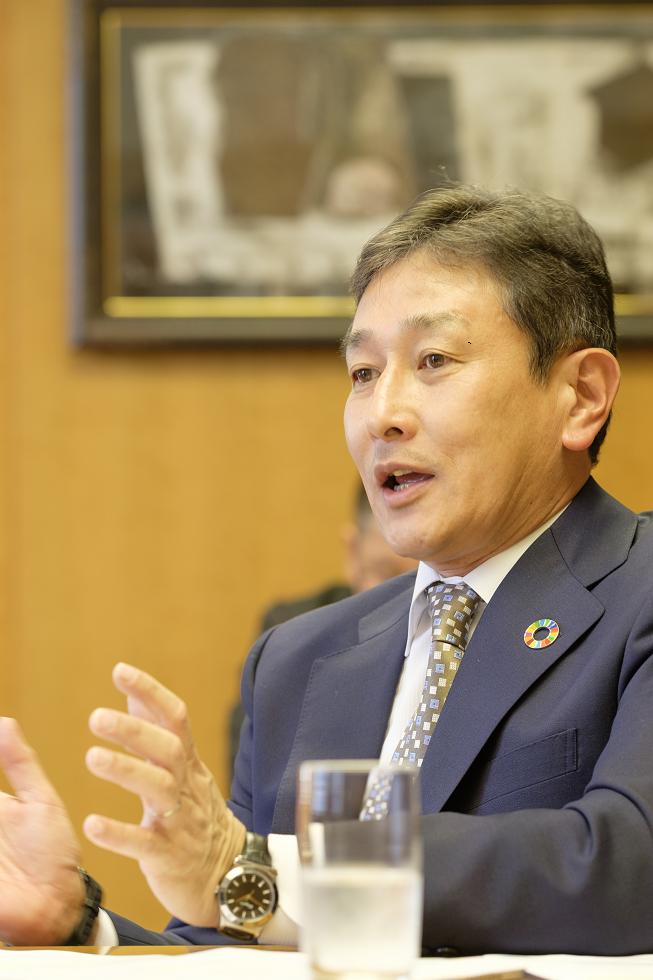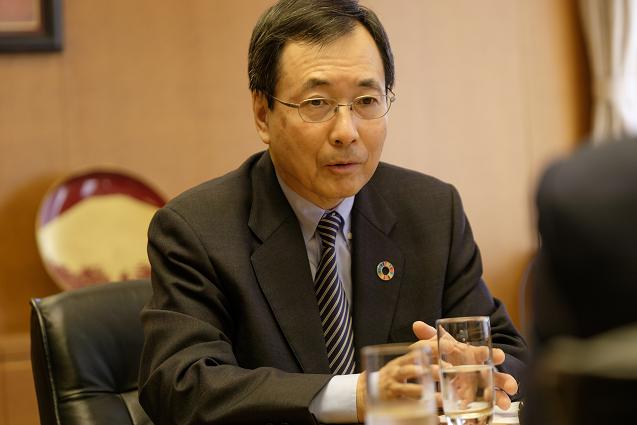How the Sompo Holdings Group Creates Value
Seki: I would like to address the next question to Mr. Aoki. As a Group, how should we interpret the SDGs and how can we integrate the SDGs into our Group’s “theme park for the security, health, and wellbeing” strategy? Or how do we create value for society and for SOMPO group by addressing SDGs?
Aoki: It is now common to hear the SDGs discussed within the Group. Over the past couple of years, the concept has taken root as the common language throughout the world. I believe that it is extremely important to integrate the concept of the SDGs into our business and management going forward.
On June 29th, Sompo Japan inherited the tenure of chair of the General Insurance Association of Japan (GIAJ) and President Keiji Nishizawa was appointed as the chairman. In his statement at a press conference shortly after his appointment, he announced two initiatives he would like to focus on. The first being the GIAJ’s contribution to achieving the SDGs, and the second being its contribution to realizing “Society 5.0.” From a disaster preparedness and accident prevention perspective, our industry is well acquainted with the SDGs and so each company strongly recognizes the incentive and need to address them. We will be the leader in efforts to achieve the SDGs not only as Sompo Japan, the company that currently chairs the GIAJ, but also as the Sompo Holdings Group.

Our vision is to achieve our management strategy, turning into “theme park for the security, health, and wellbeing.” This strategy has been set out and repeatedly advocated by top management, and is currently being developed. Our Group started out as a P&C insurance company and has the ability to restore a negative state to zero in times of need. We are also undertaking, for example, initiatives relating to disaster preparedness to maintain zero at zero. But I feel that this is the most we can do with our P&C insurance products.
To achieve a “theme park for the security, health, and wellbeing,” we need to make zeros into positives by ensuring people can live long, healthy and fulfilling lives. To put it another way, we will not be able to realize this theme park unless we come up with a business model that converts zeros and minuses to positives. Specifically, we should focus not just on our P&C insurance business, but also on our life insurance business that can contribute to health promotion, and in our nursing care business, we should help protect against dementia and support patients with dementia to enjoy life as long as possible.
As an example of our specific initiatives, our life insurance business strives to become a health support enterprise. Aiming to provide “Insurhealth,” a new value that combines insurance and healthcare, we launched an income compensation insurance product Linkx: Protection for You and Your Family in April 2018. Through this product, we refund insurance premiums (equivalent amount) to customers who are acknowledged as having improved their health by giving up smoking, losing weight or other means, which embodies our efforts to transform into a company that supports customers’ health. The nursing care business is working on measures to address dementia from a preventative perspective and is setting up a Group-wide project. Through collaboration between our P&C, life, and nursing care businesses, we plan to provide the services that introduce customers to nursing care facilities, and the counselling services to ease dementia with app-based support.
We recognize that realizing a “theme park for the security, health, and wellbeing” in this way shall be solving social issues and in turn leading to the realization of the world that the SDGs have been aiming to achieve. In other words, rather than working to achieve the SDGs, we are operating under the awareness that our management strategies in themselves shall contribute to achieving the SDGs.
Seki: What are you doing specifically to realize the group vision? What are the main points to be mentioned?
Aoki: The use of digital technology is the key to realizing a “theme park for the security, health, and wellbeing,” and we believe the driving force is “Digital x Personnel.”
Integrating digital technology into our business successfully is extremely important in order to successfully build a business model to achieve our theme park vision. Focusing on the use of digital technology does not mean we do not involve humans. We should think about how we can generate added value by combining digital technology with personnel. In addition to our labs in Tokyo and Silicon Valley, we opened a new Digital Lab in Israel, seeking opportunities to use the latest digital technology for our Group’s business.
Like Mr. Futamiya said, as SDGs’ Goal 17 (strengthen the means of implementation and revitalize the global partnership for sustainable development) indicates, I believe it is important to solve complicated social issues through partnership and cooperation with various stakeholders, as with industry-academia collaboration.

Seki: What are the signature products and services for realizing the “theme park for the security, health, and wellbeing”?
Aoki: In our P&C insurance business, examples are the products and services that help improve disaster resilience, such as Smiling Road and Portable Smiling Road (safe driving support services) which use big data analysis and telematics. We also offer “DRIVING!” which uses a drive recorder to provide peace of mind to inexperienced drivers. In our nursing care business, we plan to launch the “Oyako no Chikara” product that supports workers (children) to continue working while looking after their parents in October 2018. This will be the first product in the industry to help promote a better balance between work and family care responsibilities. We developed this product to address the social issue of separation from work in order to give care, and it exhibits synergy in combination with the referral service to introduce long-term care facilities of Sompo Care, our group company.
To address climate change we offer insurance products to photovoltaic and wind power generation companies from a mitigation perspective promoting further use of renewable energy.
Seki: Mr. Aoki, as Group CBO, you are responsible for both corporate communications and CSR. I think by overseeing two departments, you have an opportunity for bringing about synergy.Is the synergy actually being produced?
Aoki: Regarding corporate communications, I’ve noticed increasing interest from mass media in our ESG and SDGs initiatives. I sense transmitting information on our CSR initiatives in this way greatly helps improve our corporate and brand value, and our efforts are being evaluated positively.
We are also engaged in a number of cultural and arts-related activities, which provide education so that a wide variety of people can live fulfilling lives. I feel that, in a broad sense, such activities are also linked to the SDGs and contribute to improving our corporate value.
Seki: Judging from my experience, stimulating internal communication is also extremely important for harnessing synergy. Would you agree?
Aoki: I think that our internal publicity tools and coordination efforts between the CSR department and the Corporate Communications department are having a positive effect on internal communication.